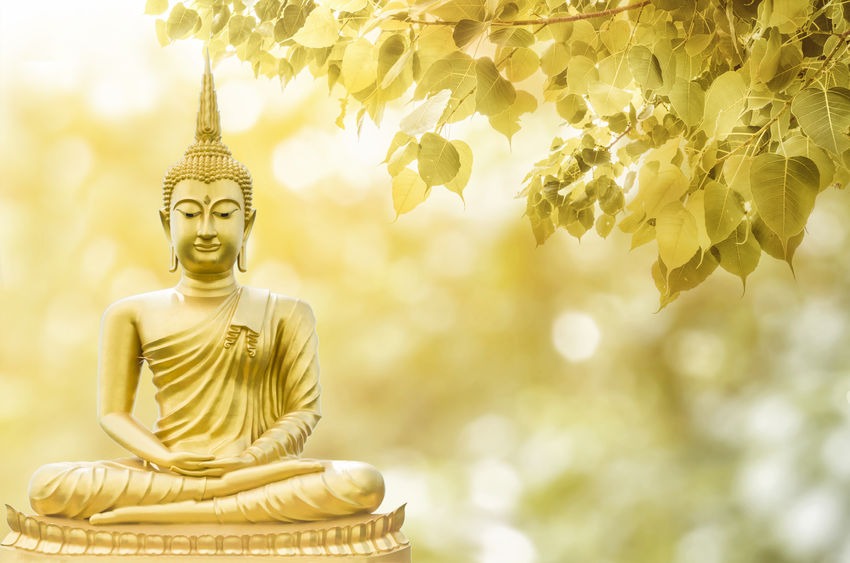Are you planning to get a Laughing Buddha statue for your home?
Are you unsure of the right placement of the Laughing Buddha figurine in your house?
If yes, keep reading this blog as we provide answers to your queries.
Vastu Shastra is an age-old science of India which sheds light on harmony and prosperous living by terminating negativity and beautifying positive energies around our home. Keeping the same thing in mind, incorporating a Buddha statue for home welcomes calmness, prosperity, happiness and good wealth. A Laughing Buddha statue at home has the potential to wipe off sadness from your life. However, placing it in the right direction and location in your house is a mandatory task!
The relationship between Vastu shastra and Laughing Buddha transpires from Feng shui. The spiritual energy that meanders through the house in the presence of a Laughing Buddha statue results in positivity and compassion.
Significance of the Laughing Buddha Statue
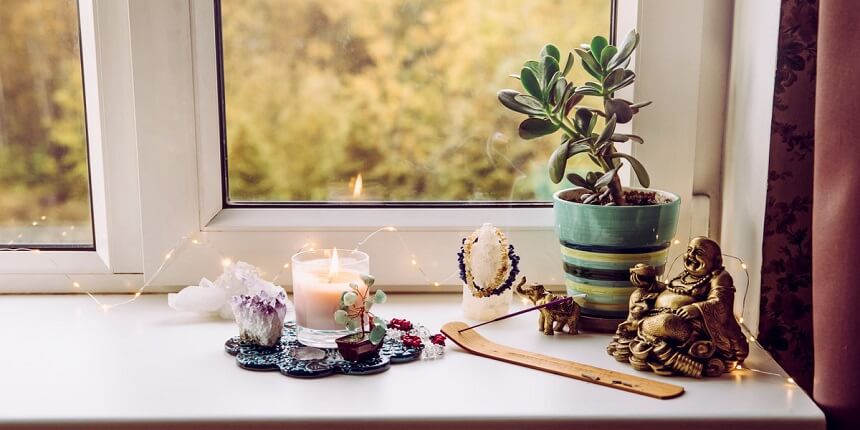
Contrary to generic assumptions, there is a vast difference between Gautam Buddha and Laughing Buddha. Also named as Budai, Laughing Buddha is a Chinese Monk from the 10th century. The energies reflected by Laughing Buddha helps to overcome obstacles, be grateful, and be happy in life. Despite being a fundamental aspect of Feng Shui, the Laughing Buddha Vastu shastra experts also encourage the installation of Laughing Buddhas for home. This is because the Laughing Buddha shares a similarity with the Indian God of Wealth, Kubera. Therefore, Indians often affiliate it with prosperity.
The statue of Laughing Buddha is available in multiple materials including metal, wood, and porcelain. It is mostly painted in gold color. A common belief says that if you rub the belly of the statue every day, all your wishes will be fulfilled.
Colours Associated with the Laughing Buddha Statue
Golden and Yellow: It is the most popular colour of the figurine which symbolizes abundance and prosperity.
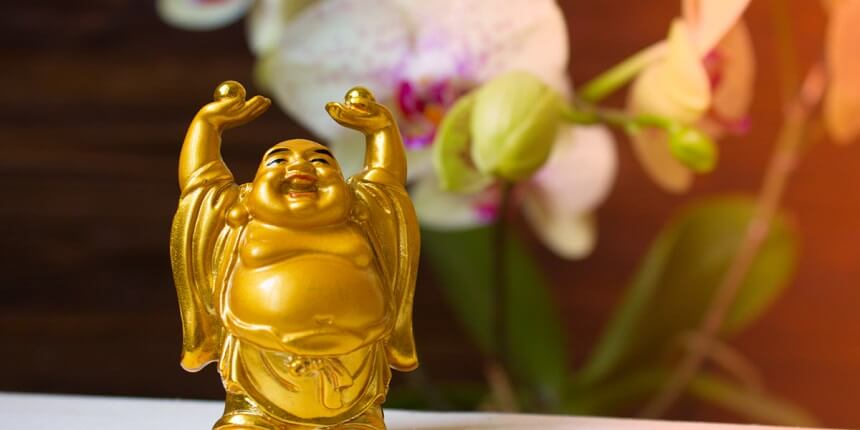
Black: Laughing Buddha in this colour represents wisdom and fluidity. It is also associated with the element of water in Chinese culture.
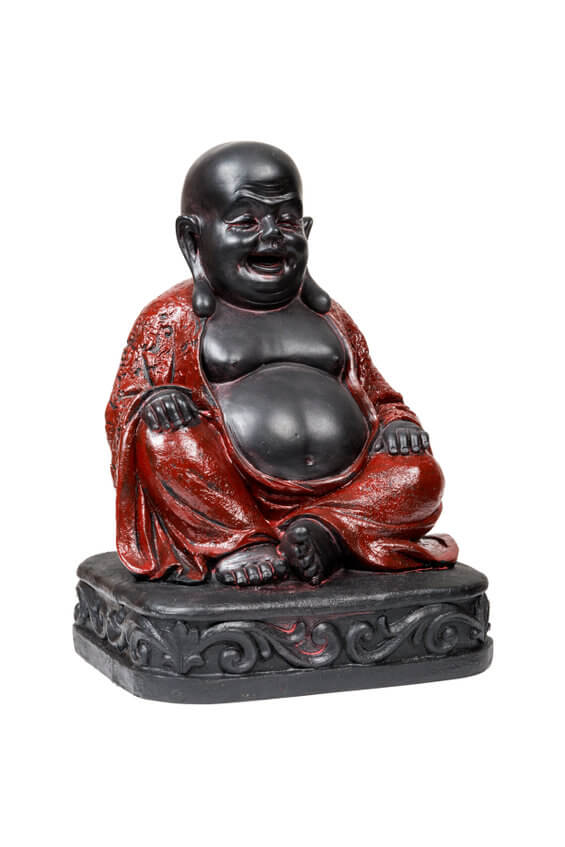
Red: Laughing Buddha in red colour is associated with fire that helps in driving passion, good fortune, and inspiration. This colour of Laughing Buddha also signifies luck and celebration.
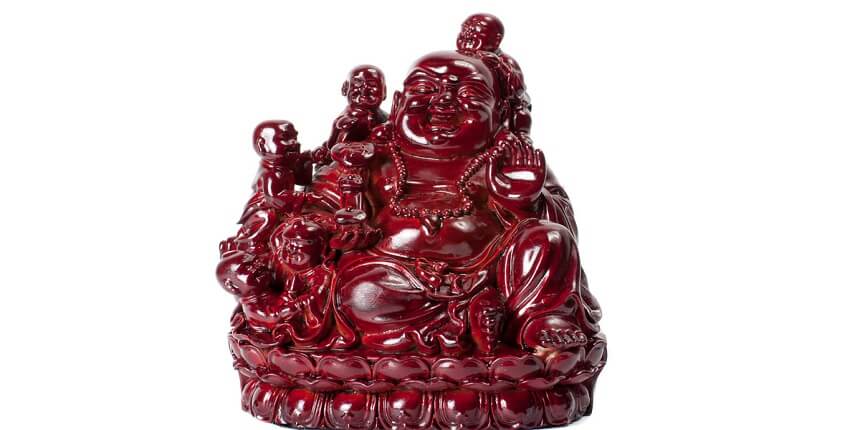
Green: The figurine of Laughing Buddha in this hue is linked with the element of wood and is a symbol of growth, harmony, and hope.
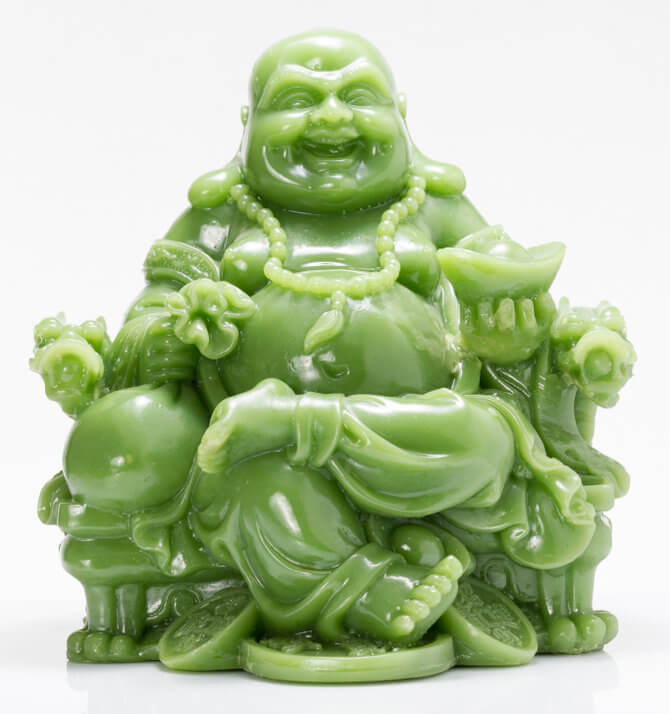
White or Silver: This particular colour of Laughing Buddha signifies peace, wealth, and happiness.
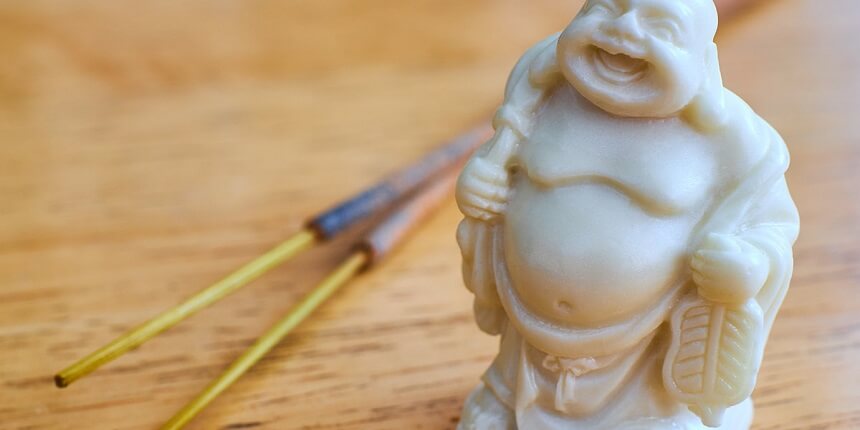
Various Forms of Buddha Statue at Home
Laughing Buddha carrying a sack of affluence
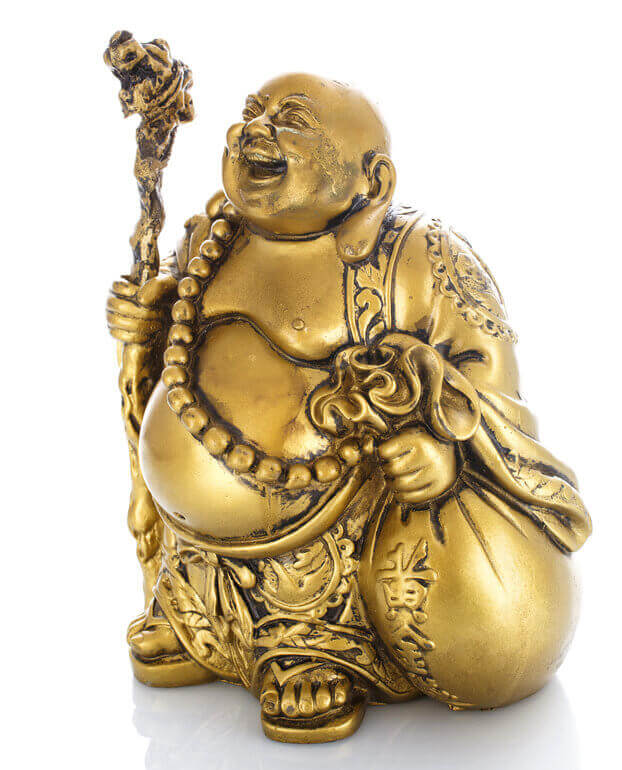
The sack held by Laughing Buddha signifies gathering all your suffering and misery & putting them in the bag. It further signifies giving positivity. The sack of Laughing Buddha is also a symbol of good fortune and wealth.
Laughing Buddha clasping beads of prosperity
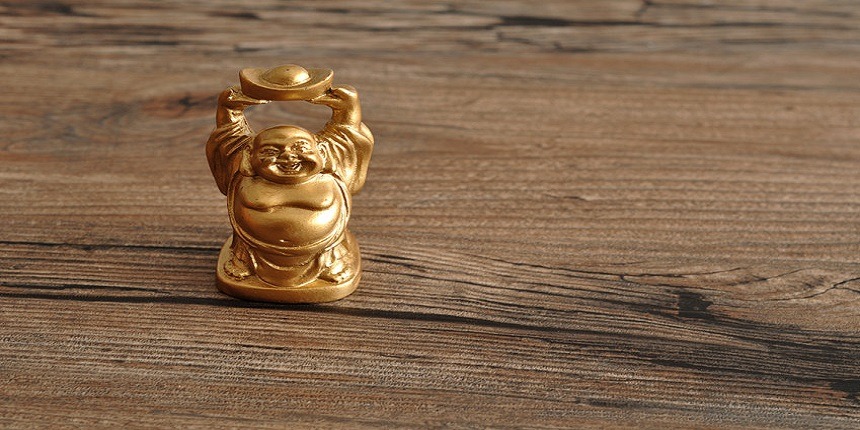
The beads of the bracelet held by the Laughing Buddha reflect spirituality. The beaded bracelet is believed to bring affluence. It is also believed that the bead bracelet is among the symbols of wisdom.
Laughing Buddha resting on a nugget
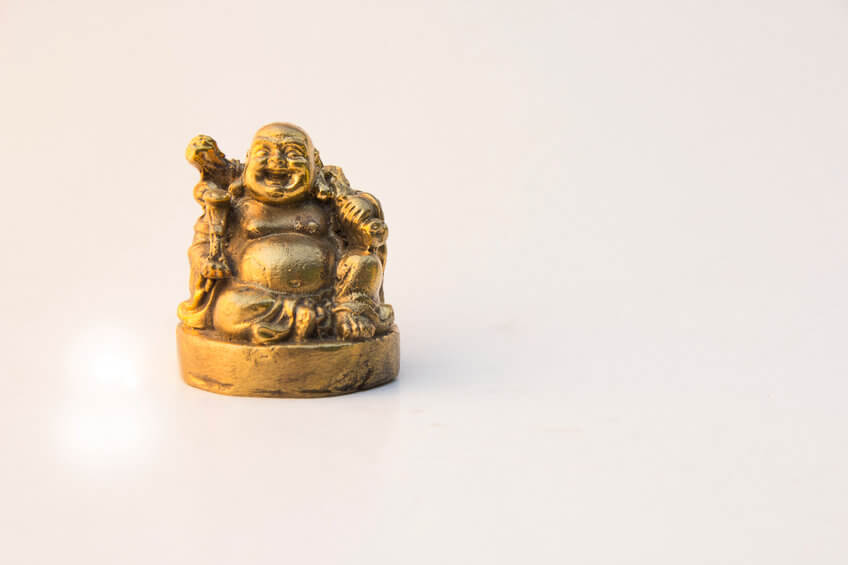
This statue of Laughing Buddha resting on a gold nugget is associated with good fortune. This figurine exemplifies a true state of merriment and wealth.
Laughing Buddha bearing a Wu Lou and a Fan
The Laughing Buddha holding a Wu Lou (bottle gourd) and a fan in either hand signify good health and fruitful manifestations. It is believed that the Wo Lou protects from sickness while the fan repels negativity.
Laughing Buddha donning a hat
This statue depicts a happy, healthy, and long life. Keep this statue in your home to get rid of your difficulties and live a pious life without unwarranted stress!
Laughing Buddha supporting gold ingots with his upright hands
This type of Laughing Buddha signifies good luck and wealth and is also known to attract prosperity and ample luck
Laughing Buddha holding a bowl
Laughing Buddha holding a bowl is a symbol of a Chinese monk who devoted his entire life to enriching people's lives with contentment and enlightenment. The bowl is a symbol of amassing a good fortune, higher wisdom, and positive vibes.
Laughing Buddha encircled by children
This form of Laughing Buddha portrays the well-being of housemates. This figurine is kept in the house to get rid of all the issues related to children. Also, it improves overall health and fertility.
Laughing Buddha resting on a Dragon Tortoise
This statue signifies a strong career and success. It portrays that you will never face challenges related to your education. The turtle is a symbol of stability, and the dragon signifies strength.
Laughing Buddha resting on an Elephant
This figurine is a symbol of wealth and merriment. The upward pointed trunk of the elephant denotes contentment, wisdom, and success. Placing the statue towards the main door in the living room harnesses positive energy.
Laughing Buddha performing meditation
A meditating Laughing Buddha represents peace and calm life. This figurine helps you manage stress with ease.
Hand Gestures associated with the Laughing Buddha Statue at Home
The hand gesture of the Laughing Buddha raising both of his hands is associated with financial freedom and the removal of negative energy. This pose is a metaphor that stands for heavenly blessings.
The palm directing outwards denotes an outpour of joy. The hand expanded in the downward direction is linked with charity.
Both the hands above the head with palms outstretched upwards is an indication of meditation and a tranquil flow of thoughts.
The left hand sitting on the lap, with palm directed upwards and the right hand that is bent on the knee with fingers moving towards the ground signifies spiritual knowledge and wisdom.
Viable Directions to Place the Laughing Buddha Statue at Home
As per Feng Shui, the placement of a Laughing Buddha in your house helps you in overcoming imbalance, bringing more harmony and prosperity in an individual’s life.
Below is the correct way that you need to follow in order to place Laughing Buddha at your home:
⮚ The east direction, which is known for the direction of sunrise, is the exact position where one should place their Laughing Buddha as well. This position is considered to be the right spot to attract good fortune in your family.
⮚ It helps in attracting harmony & happiness
⮚ In case the Buddha’s placement is done in the direction of the southeast, it is considered to bring more wealth to the family.
⮚ Laughing Buddha is said to signify balance and inner peace. When the placement of the Buddha is done in the direction of the northeast, then it suggests attracting the energy of the same corner & focusing on gaining wisdom.
⮚ It is great if the people entering your home are welcomed through the sight of the Buddha as it activates a positive mindset and releases any kind of unwanted energy. So, it is good if you place the Buddha on the corner of the table. The position of the buddha could either be opposite to the main gate or diagonal. Therefore, it is important for you to make your buddha facing inside the room & not outside.
⮚ Feng Shui states that every person has a particular direction known as the ‘Sheng Chi’. Imagine Sheng Chi as a wavy line of energy meandering through the house. The placement of the Laughing Buddha figurine in line with Sheng Chi’s direction will surely help eradicate monetary troubles and contribute to your mental well-being.
⮚ As per the Chinese culture, Laughing Buddha portrays a smiling face that brings happiness, wealth, wisdom, and prosperity. Hence, it is recommended that the statue must be placed facing the entrance.
Laughing Buddha on the Work and Office Desk
Positioning a Laughing Buddha on your office desk helps build growth opportunities in your career and reduces workplace differences. When it comes to students, placing Laughing Buddha on their respective study tables results in academic excellence.
Places to Avoid for Keeping the Laughing Buddha
⮚ You must never place the Laughing Buddha in your kitchen, toilet & bathroom.
⮚ Keep in mind to never place the Laughing Buddha directly on the floor, it is suggested to place the statue at your eye level.
⮚ Make sure the section surrounded around your Buddha is clean & clutter-free at all times.
⮚ Try and avoid placing your Laughing buddha near any electrical outlets be it motors, or any kind of electronic appliance since it disturbs the aura and blocks all the good energy around you.
⮚ Never place your Laughing Buddha statue on the head of the shoe rack.
You May Also Like
| Vastu for Kitchen |
| Vastu vs Feng Shui |
| 7 Horse Painting Vastu |
| House Plan with Vastu |
| Pooja Room Vastu |
| Vastu tips to Remove Negative Energy |
| Vastu for Hotel |
| Staircase Direction as per Vastu |
Frequently Asked Questions
Is a Laughing Buddha lucky?
Of course, the Laughing Buddha is called Hotei by the Chinese and considered highly positive, lucky and auspicious. It is mostly positioned where it faces the door. The big protruding stomach indicates luck, happiness and prosperity. The Laughing Buddha fused with Lord Ganesha is also lucky for the household.
What is the real story of Laughing Buddha?
The image of the Laughing Buddha is based upon a Chinese Zen monk called Hotei or Pu-Tai who lived more than 1, 000 years back. People saw him as a future Buddha owing to his benevolence and generosity. His large belly and smile made him get the epithet of Laughing Buddha.
What is the use of Laughing Buddha?
The Laughing Buddha is used in Vastu and Feng Shui for infusing abundance, prosperity, good luck, good health and success into any area owing to the positive energy of the Laughing Buddha which spreads throughout the household.
What type of Laughing Buddha should be kept at home?
You can keep Laughing Buddha statues which show the deity playing with children, indicating good fortune from the Heavens. A Buddha with a bag or sack of gold coins is a sign of prosperity. A Laughing Buddha with a fan or bowl (indicating the life of a monk) are also prosperous for the home. You can also find Laughing Buddha idols with balls or beads. These are some types of Laughing Buddha statues that you can keep at home.
Which is the biggest Buddha statue in the world?
The biggest Buddha statue in the world is the Leshan Giant Buddha, standing at a height of 71 meters. It was built by the Tang dynasty between 713 and 803.
Which type of Laughing Buddha symbolizes wealth?
Laughing Buddha with a sack symbolizes wealth and gathers everyone's misery & suffering.
In which direction should we place the Laughing Buddha for obtaining good luck?
For obtaining good luck, the Laughing Buddha should be placed facing the east, the direction of the sunrise.

